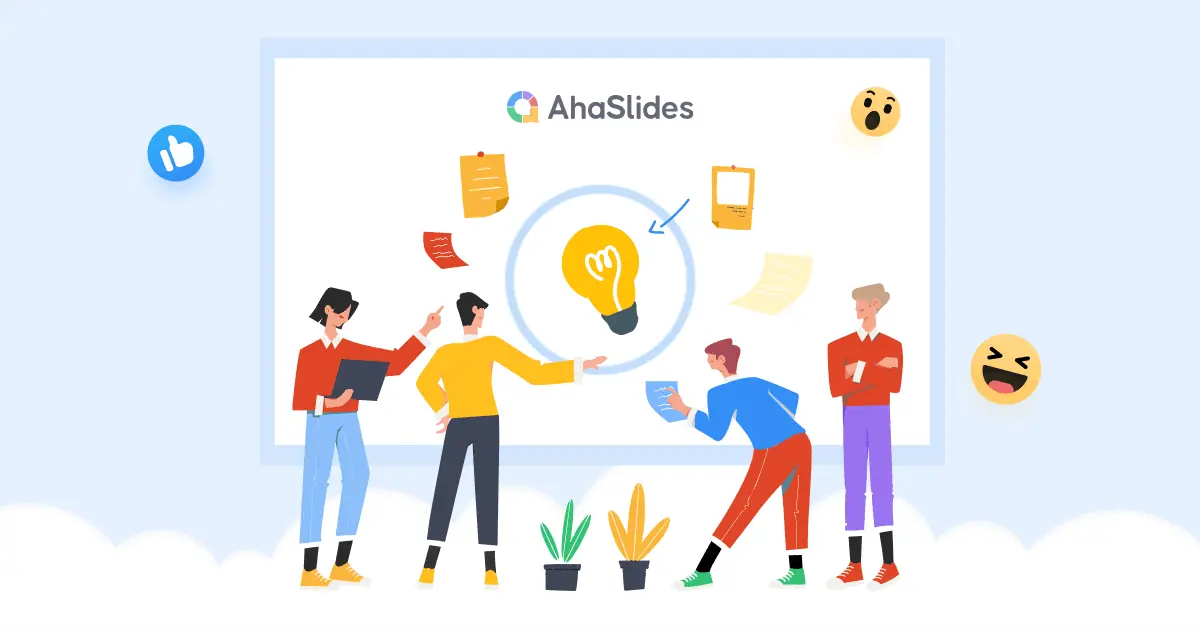Nuovo nell'insegnamento online? I pro ei contro dell'e-learning possono essere un po ' non chiaro All'inizio.
Eppure, con le nostre classi e il nostro mondo che sta diventando sempre più remotoNon c'è mai stato un momento migliore per scoprire il cosa, il perché e il come dell'istruzione digitale.
Ecco un elenco completo di 20 pro e contro di e-learning in un'aula virtuale dal vivo, nonché 4 strumenti gratuiti che può aiutare le tue classi a coinvolgere più studenti remoti!
La tua guida ai pro e ai contro dell'e-learning
- I 12 vantaggi dell'e-learning
- Gli 8 contro dell'e-learning
- 4 strumenti gratuiti per la Live Virtual Classroom
I 12 vantaggi dell'e-learning
1. Flessibilità
Cominciamo con l'ovvio, va bene?
La capacità di imparare da qualsiasi luogo, senza la necessità di spostarsi, è probabilmente uno dei maggiori vantaggi dell'e-learning.
È un'ancora di salvezza assoluta per gli studenti che...
- Live in Aree remote.
- Devo arrivare trasporto pubblico a scuola.
- Dovrebbe essere più vicino a casa per motivi medici o di altro tipo.
E non stiamo parlando solo di flessibilità geografica. Flessibilità nel tempo significa che gli insegnanti, avendo una buona dose di autorità sui propri orari di lezione, possono organizzare le lezioni online in base alle vite dei loro studenti.
Se è una bella giornata fuori e tu sei uno di quelli 'freddo' insegnanti, i tuoi studenti potrebbero non avere problemi a riprogrammare la lezione per la sera.
2. Enorme aumento delle competenze indipendenti

Il fatto che il lavoro di gruppo non sia così diretto nell'apprendimento a distanza non è necessariamente una cosa negativa. Mette più enfasi sul lavoro indipendente, che più tardi nella vita probabilmente si formerà la maggior parte del lavoro svolto dagli studenti.
In effetti, questo è particolarmente utile se si insegna a studenti delle scuole secondarie (superiori). Un maggiore lavoro individuale li prepara bene per l'università, dove ci si aspetta che lavorino in modo ampiamente indipendente.
Ovviamente, niente di tutto questo vuol dire che il lavoro di gruppo sia completamente fuori discussione. La maggior parte dei software di videochiamata consente stanze per sottogruppi di lavoro, in cui gli studenti possono eseguire lavori di gruppo in una videochiamata separata prima di rientrare in quella principale.
3. Preparazione per un futuro remoto
Tra tutti i pro e i contro dell'e-learning, questo sarà probabilmente quello che avrà il maggiore impatto a lungo termine sul futuro lavorativo dei tuoi studenti.
Sappiamo tutti che ci stiamo dirigendo verso un futuro lavoro a distanza, ma le statistiche dicono che potrebbe arrivare prima di quanto pensi:
- Entro il 2025, intorno 70% della forza lavoro statunitense lavorerà da remoto per almeno 1 settimana lavorativa al mese.
- A seguito della pandemia di Coronavirus, il numero di lavoratori remoti permanenti nel 2021 dovrebbe doppia dal 16.4% al 34.4%.
Probabilmente non abbiamo bisogno di una sfera di cristallo per capire che il futuro dei vostri studenti sarà ricco di videochiamate su Zoom. Fornire loro questa competenza ora potrebbe non sembrare un'abilità, ma la familiarità con le videochiamate online sarà sicuramente utile in futuro.
4. Molto più interattivo
La triste verità del sistema scolastico moderno è che non è affatto moderno. Insegniamo ancora ai nostri studenti in gran parte attraverso lo stesso flusso unidirezionale di informazioni che avevamo in epoca vittoriana.
L'e-learning ci dà la possibilità di farlo capovolgi lo script.
Gli strumenti interattivi online disponibili nel 2021 consentono agli insegnanti di coinvolgere realmente i propri studenti attraverso dialoghi a due e di gruppo. Ecco alcuni modi per coinvolgere gli studenti con pochissima preparazione...
- Domande e risposte – Una sessione ordinata di domande e risposte in cui gli studenti possono porre domande all'insegnante, in forma anonima (o meno), sull'argomento. Queste sessioni di domande e risposte possono essere salvate per essere riesaminate in seguito.
- Sondaggi dal vivo – Domande a risposta multipla poste in tempo reale, sulle quali gli studenti possono votare da casa. Possono essere utilizzate per raccogliere opinioni o verificare la comprensione di un argomento.
- Brainstorming – Domande aperte e nuvole di parole consenti ai tuoi studenti di esprimere liberamente le proprie idee e di discutere quelle degli altri.
- Quiz – Un metodo super divertente, basato sui punti, per testare la comprensione in una squadra o da soli è un quiz dal vivoIn alcuni software, le risposte ai quiz di ogni studente possono essere inserite in un report analitico.

Alzate la voce, alzate le mani.
Dai un'occhiata a questo modello di coinvolgimento di 12 slide su AhaSlides. Sondaggi, scambi di idee, quiz e giochi: non è necessario alcun download. 100% da!
5. L'utilizzo di documenti in linea è di gran lunga superiore

Come abbiamo detto, l'istruzione non è l'unica cosa ad essere passata online nel 2020. I software collaborativi online, come Miro, Trello e Figma, hanno davvero fatto un salto di qualità all'inizio del decennio.
Per gli insegnanti, uno dei maggiori vantaggi dell'e-learning negli ultimi anni è stato Google drive. In modo assolutamente gratuito, consente loro di creare e condividere documenti e cartelle, tenere traccia dei compiti e collaborare con altri insegnanti sui materiali per gli studenti.
Per gli studenti, avere accesso alle cartelle condivise significa avere tutto già perfettamente organizzato. Possono lasciare commenti su tutto ciò che non capiscono e ricevere risposta dall'insegnante o dai compagni.
6. Super verde
Ecco uno dei pro e dei contro dell'e-learning che potrebbe avere un impatto enorme sul futuro dei tuoi studenti.
Passare all'apprendimento online significa allontanarsi da consumare energia In una scuola fisica. Luci, gas, attrezzature, ecc., tutto è energia risparmiata! Per non parlare del fatto che una scuola media può risparmiare letteralmente milioni di litri di carburante ogni anno per i trasporti di studenti e insegnanti.
Naturalmente, questo ha molti effetti positivi. Oltre a giovare al futuro di tutti, probabilmente ne trarrai anche un notevole beneficio per il tuo portafoglio.
7. Facile da organizzare e ricapitolare
Nel modello offline, le lezioni sono solo brevissime esplosioni di informazioni che devono confrontarsi con le distrazioni quotidiane di uno studente in crescita. Spesso è difficile per uno studente ricordare qualcosa che ha imparato il giorno prima.
In linea, questo è molto meno un problema. Gli studenti possono accedere alle informazioni precedenti molto, molto più facile:
- Domande e risposte - Una sessione di domande e risposte scritta significa che tutte le domande poste in una lezione vengono registrate.
- Sessioni di registrazione – Il software di video live ti consente di registrare la tua lezione e condividere l'intera cosa, o parti selezionate di essa, con i tuoi studenti.
- Cartelle condivise – Tutti gli studenti possono accedere ai registri delle domande e risposte, alle registrazioni video, ai documenti, ai materiali e a molto altro ancora dalle cartelle online condivise.
Nell'e-learning tutto è permanente. Non ci sono lezioni, discussioni o sondaggi una tantum; tutto ciò che insegni o discuti con i tuoi studenti può esserlo registrato, documentata e chiamato ogni volta che le informazioni devono essere riviste.
8. Molta supervisione
Si potrebbe pensare che sia facile per i bambini rilassarsi quando l'unica cosa che li tiene incollati al loro apprendimento è una macchina fotografica.
Bene, quando anche i genitori lavorano da casa, gli studenti sono molto più incentivati a rimanere concentrato sul loro apprendimento.
Naturalmente, la tecnologia serve anche a colmare le lacune. Ci sono diversi pezzi di software libero per visualizzare gli schermi dei computer degli studenti, prenderne il controllo e bloccare lo schermo dello studente se si rifiuta di collaborare.
9. A prova di pandemia
Probabilmente lo avrai capito da solo: l'e-learning sarà il modo migliore per continuare la formazione quando arriverà la prossima pandemia.
Sebbene il Coronavirus sia stato un po 'complicato test per l'e-learning, possiamo presumere che insegnanti e studenti lo saranno molto meglio preparato la prossima volta. Quando ciò accade, i governi e le scuole possono finanziare e adottare procedure di e-learning per garantire che l'apprendimento non venga interrotto.
Ci sarà meno formazione e gli studenti dedicheranno meno tempo ad abituarsi ai cambiamenti.
L'alternativa, un full 2 anni di tradizione fuori dalla scuola, non ci penso nemmeno.
10. Partecipazione anonima
Come insegnanti, ci siamo chiesti tutti come far parlare i bambini timidi.
La realtà è che gli studenti che sono riluttanti a parlare davanti alla classe sono molto più propensi a contribuire se possono farlo in modo anonimo.
Un sacco di software interattivo edtech consente agli studenti di rispondere e porre domande in modo anonimo, nonché di avviare discussioni senza timore di imbarazzo. Fare questo non solo li aiuta ad imparare, ma in modo coerente crea una fiducia preziosa se fatto e lodato ripetutamente.
11. Piani di lezione scaricabili
Ricorda che i numerosi pro e contro dell'e-learning non riguardano solo gli studenti, ma anche gli insegnanti.
In media a settimana, gli insegnanti spendono 12-14 ore del proprio tempo fare piani di lezione e segnare Ma la nuova tecnologia consente agli insegnanti di prendere a Enorme tagliare questo tempo di preparazione.
Ora, ci sono vaste biblioteche di piani di lezione, argomenti di discussione, valutazioni e quiz, realizzati e condivisi da colleghi insegnanti immediatamente scaricabile gratuitamente su software edutech.
⭐ Vuoi un pezzo di quella torta che fa risparmiare tempo? Di seguito è riportato un fantastico modello gratuito.
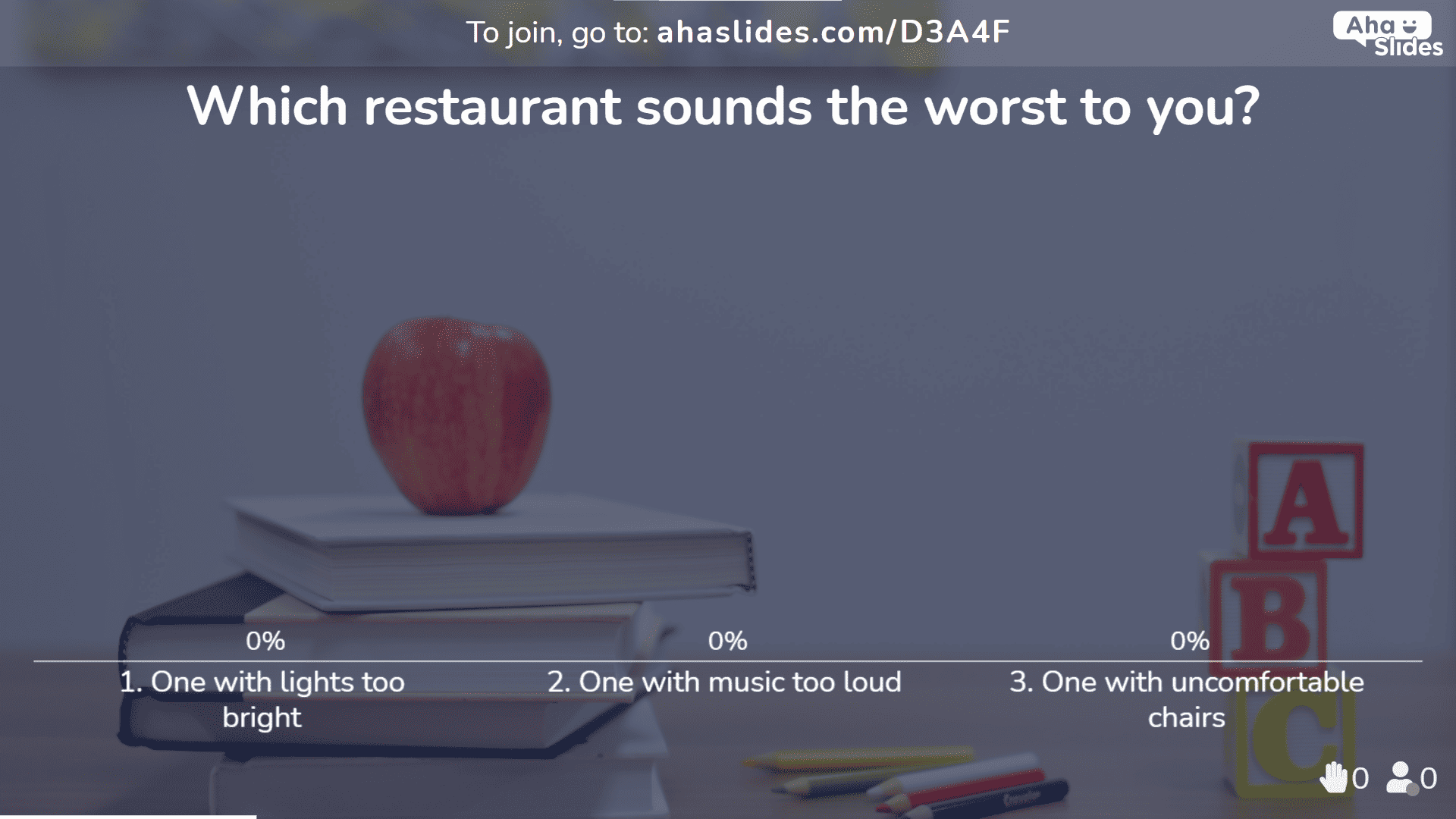
Modello gratuito
Valutazione dello stile di apprendimento
Scopri gli stili di apprendimento dei tuoi studenti con questo sondaggio di 25 domande.
Provalo gratis!
Per utilizzare questo modello:
- Fare clic sul pulsante in alto per vedere il modello.
- Modifica tutto ciò che ti piace del modello (domande, colori, immagini, ecc.)
- Condividilo con i tuoi studenti tramite il codice univoco della stanza. Possono rispondere a tutte le domande e discussioni (dal vivo o non dal vivo) utilizzando i loro smartphone.
⭐ Psst, fare clic qui per saperne di più su come utilizzare il valutazione dello stile di apprendimento modello.
12. Analitica organizzata
Fermateci se l'avete già sentito: gli esami sono lontano dal modo migliore per valutare le prestazioni dei tuoi studenti.
La valutazione coerente durante tutto l'anno è più efficace e altamente preferito dalla maggior parte degli studenti a un esame una tantum carico di stress alla fine.
Gli strumenti analitici Edtech aiutano gli insegnanti a misurare le prestazioni degli studenti in ogni quiz a cui partecipano. Ecco cosa rivelano e come possono rappresentare un enorme vantaggio per l'apprendimento online:
- Risultati complessivi (percentuale di studenti che hanno risposto correttamente).
- Domande più difficili (rivela le domande con le risposte meno corrette).
- Prestazioni di ogni studente nel quiz.
- Rapporto sulle prestazioni di ogni studente rispetto alle prestazioni precedenti.
Le analisi sono disponibili per il download in un foglio di calcolo completo. I fogli di lavoro sono super organizzato e facile da cercare, che è un passaggio estremamente gradito dalle fitte cartelle degli studenti che si riempiono di valutazioni cartacee.
Brainstorming migliore con AhaSlides
- Generatore di nuvole di parole dal vivo | Creatore gratuito di cluster di parole numero 1 nel 2024
- 14 migliori strumenti per il brainstorming a scuola e al lavoro nel 2024
- Scheda delle idee | Strumento di brainstorming online gratuito
Gli 8 contro dell'e-learning
1. Il coinvolgimento non è facile

Di tutti i pro e contro dell'e-learning, questo è probabilmente il commento più comune che sentiamo.
Se hai già insegnato online, ti sarai trovato di fronte a un muro di volti di studenti silenziosi. Nessuno è coinvolto e ecco probabilmente perché:
- Gli studenti si stanno ancora abituando a un ambiente non familiare.
- Gli studenti si sentono sovraesposti avendo la loro faccia sullo schermo in modo che tutti possano vederla.
- Gli studenti sono distratti dalle cose a casa.
- Gli studenti non hanno la possibilità di lavorare in gruppo.
- Gli studenti sono abituati a lezioni attive.
- L'insegnante non sa come modificare il suo approccio abituale per adattarsi agli studenti online.
- Il software utilizzato dagli studenti è troppo confuso o non è stato spiegato loro adeguatamente.
Come risolvere il problema…
In realtà, potrebbero esserci diversi motivi per cui i tuoi studenti stanno lottando per trovare l'attenzione necessaria per la tua lezione online. In qualità di insegnante, il tuo lavoro è superare questi ostacoli con le lezioni so coinvolgente al punto che i tuoi studenti non riescono a distogliere lo sguardo.
Creare lezioni online coinvolgenti non è una passeggiata, ma ecco alcuni rapidi suggerimenti da mettere subito in pratica:
- Usa live software interattivo (con sondaggi dal vivo, quiz e tutte le cose buone di cui abbiamo parlato sopra).
- Usa il attività rompighiaccio nelle lezioni per calmare la tensione iniziale. (Abbiamo un sacco di idee proprio qui!)
- Usa il stanze per sottogruppi di lavoro sul tuo software video per passare dal lavoro solista al lavoro di gruppo.
2. Non tutti hanno la tecnologia
In parole povere, non puoi aspettarti che tutti i tuoi studenti siano in grado di ottenere la tecnologia necessaria per partecipare alle lezioni online. Alcuni di loro potrebbero provenire da famiglie svantaggiate e potrebbero non avere i fondi necessari per un computer portatile, una connessione internet decente o software a pagamento.
Inoltre, molti studenti sono meno dotati di tecnologia rispetto ad altri. Anche con la tecnologia, e anche con la guida, potrebbero avere difficoltà a capire come usarla.
Come risolvere il problema…
Se hai il potere di farlo, il modo migliore per risolvere questo enorme svantaggio di e-learning è provare apprendimento asincronoQuesto è l'apprendimento attraverso materiali impostati a cui è possibile accedere in qualsiasi momento della giornata senza la necessità di un vivere classe virtuale.
In questo modo, gli studenti possono partecipare all'e-learning quando e dove possibile. Possono usare i computer in biblioteca o a casa di amici per dedicarsi allo studio senza essere ostacolati dalla mancanza di tecnologia a casa propria.
3. Problemi tecnici
Tutti noi, ad un certo punto della nostra vita, ci siamo trovati in una posizione in cui la tecnologia precedentemente impeccabile ci ha deluso. bisogno momento in cui ne abbiamo bisogno.
"Frustrazione" non è sufficiente, e "rabbia apopletica" è qualcosa che ovviamente non dovresti mai mostrare di fronte ai tuoi studenti.
Purtroppo si verificano problemi tecnici. Possono creare scompiglio nelle aule virtuali, sradicare il flusso costruttivo della lezione e portando gli studenti a diventare dirompenti o completamente disinteressati.
Come risolvere il problema…
Non puoi mai prevedere un problema tecnico, ma puoi sempre prepararti a aggirare il problema:
- Test! Sembra ovvio, vero? Tuttavia, ci sono molti insegnanti che usano il nuovo software senza dargli uno sguardo approfondito in anticipo. Prova ogni funzione che prevedi di utilizzare due o 3 volte.
- Backup! Anche dopo i test, alcuni nuovi problemi che inducono rabbia possono sorgere dal nulla. Trova un software che offra un servizio simile alla tua prima scelta e rendilo la tua seconda scelta.
4. Più difficile controllare la classe
Abbiamo detto prima che un professionista dell'e-learning è che la quantità di supervisione che gli studenti ricevono aumenta effettivamente online. Tuttavia, sebbene siano disponibili strumenti di gestione della classe, ti consentono solo di affrontare gli studenti che si comportano male individualmente.
Se si è alle prese con una rivolta di classe, può essere difficile sapere cosa fare.
Come risolvere il problema…
Non esiste una soluzione universale per questo. Ecco solo alcuni modi per affrontare le tue lezioni virtuali. ridurre al minimo il rischio di comportamenti scorretti:
- Impostare il norme chiaramente all'inizio del corso, o anche all'inizio di ogni lezione.
- Massimizza il interazione degli studenti nella tua classe: sia da insegnante a studente che da studente a studente.
- Conserva le cose vario – una lezione stagnante e noiosa è un terreno fertile per comportamenti scorretti.
5. L'insegnamento individuale può soffrire

Indipendentemente da chi, cosa o come stai insegnando, alcuni dei tuoi studenti avranno bisogno una mano d'aiuto.
Nell'aula fisica, un insegnante può semplicemente passeggiare per la stanza e aiutare chi ha bisogno di assistenza. Nell'aula virtuale, questa interazione uno contro uno è resa più complicata da altri 29 studenti che ascoltano.
Per gli studenti timidi o con difficoltà di apprendimento, il solo pensiero di un incontro "a tu per tu" così pubblico può essere sufficiente a farli desistere dal chiedere aiuto. Eppure, un simile cedimento nell'apprendimento può essere molto dannoso per la loro comprensione futura.
Come risolvere il problema…
Solo perché tecnicamente non hai un ufficio non significa che non puoi averlo orario di ufficio virtuale.
Far sapere ai tuoi studenti che possono parlare con te privatamente e virtualmente in qualsiasi momento li incentiva notevolmente a cercare aiuto anche al di fuori delle lezioni. Affrontare le difficoltà di apprendimento individuali in questo modo è più equo nei confronti del tuo studente e non ostacola l'apprendimento degli altri.
6. Più difficile socializzare per gli studenti
Quando i tuoi studenti ripensano con affetto ai loro giorni di scuola, è improbabile che menzionino qualcosa di ciò che è accaduto nel 2020-21.
I giorni spensierati di cui parliamo sempre con entusiasmo da adulti stanno svanendo per gran parte di questa generazione. Socializzare è una parte enorme della scuolae non c'è nulla di virtuale che possa davvero replicarlo...
Come risolvere il problema…
…Tranne i videogiochi.
Se mai ci sarà un momento per consigliare i videogiochi ai tuoi studenti, ora è quel momento.
Per molti studenti, i giochi multiplayer sono serviti come un'ancora di salvezza sociale in blocco. Lavorare insieme nei giochi può sostituire alcune delle interazioni, l'unità e il semplice divertimento che mancano nell'e-learning.
Se i tuoi studenti non amano i giochi, ci sono alcune fantastiche attività di gruppo online per bambini proprio qui.
7. Zoom fatica
Immagina, in passato, di avere tutte le tue classi nella stessa identica stanza per 2 anni di fila. Non è una bella idea, vero?
Non molto tempo dopo aver iniziato, otterrai sicuramente stanchezza della stanza. Ebbene, oggigiorno gli studenti stanno combattendo Fatica dello zoom; il prodotto di stare seduti nella stessa stanza, fissando lo schermo di un computer per più di 6 ore al giorno.
Gli studenti più giovani hanno particolarmente bisogno stimolazione visiva e uditiva, ma il più delle volte, l'aula virtuale non riesce a fornirlo. Può portarli a perdere la concentrazione durante le lezioni e diventare demotivati nell'apprendimento.
Come risolvere il problema…
Tra tutti i pro e i contro dell'e-learning, questo è probabilmente il più difficile da comprendere. La "fatica da Zoom" è un fenomeno che si accumula nel tempo e, allo stesso modo, può essere contrastata solo con un'azione costante e a lungo termine.
Dai un'occhiata a queste idee divertenti e faticose:
- Decora la tua classe – Dedica del tempo alle lezioni con gli studenti per creare decorazioni a tema in base alla materia del tuo corso. Poi, chiedi loro di appenderle in giro per la loro classe.
- Costumi a tema – Assegna come compito a casa la creazione di un costume a tema basato su ciò che stai insegnando. Gli studenti possono usare qualsiasi materiale, ma devono spiegare il loro costume quando arrivano in classe.
- Giocare – I giochi educativi possono aiutare a mantenere alta la concentrazione e a distogliere la mente dal fatto che si è all'ottava lezione Zoom della giornata. Ecco una lista di idee di giochi virtuali davvero interessanti. proprio qui!
8. Mancanza di movimento
Lo sapevi dopo 10 minuti di seduta, i bambini iniziano a perdere la concentrazione e si sentono assonnati? Sebbene il tempo sia ritardato per gli studenti più grandi, si applica lo stesso principio: i tuoi studenti bisogno di muoversi.
Una delle curiosità dei pro e dei contro dell'e-learning è che c'è sia flessibilità che rigidità. In termini di rigidità, gli studenti di solito usano una sedia nell'aula virtuale e hanno pochissimi incentivi a lasciarla durante la giornata scolastica.
Oltre all'effetto psicologico noioso che questo ha sui tuoi studenti, incoraggia anche la pigrizia e può condurre a un percorso molto malsano.
Come risolvere il problema…
Date un'occhiata a queste fantastiche pause per il cervello, che funzionano a meraviglia soprattutto con gli studenti più giovani...
- Movimenti a scelta multipla – Se la domanda è a risposta multipla, fornisci a ogni opzione di risposta un movimento di accompagnamento. Gli studenti rispondono eseguendo il movimento corrispondente alla risposta scelta.
- Caccia al tesoro – Date agli studenti un limite di tempo per trovare tutti gli oggetti domestici in una lista e poi mostrateli alla telecamera. Per gli studenti più grandi, gli oggetti possono essere più concettuali.
- Qualsiasi cervello corto irrompe questo fantastico articolo!
Sondaggio efficace con AhaSlides
- Cos'è una scala di valutazione? | Creatore di scale di sondaggio gratuito
- Ospita domande e risposte in diretta gratuite nel 2024
- Porre domande aperte
- 12 strumenti di sondaggio gratuiti nel 2024
4 strumenti gratuiti per la Live Virtual Classroom
Abbiamo quindi esaminato in modo approfondito alcuni dei pro e dei contro dell'e-learning che è necessario considerare per l'aula virtuale in presenza. Per eliminare gli svantaggi e sottolineare i vantaggi dell'apprendimento online, è necessario: piuttosto grande cassetta degli attrezzi.
Scopri di seguito questi strumenti di e-learning gratuiti...
Strumento n. 1 – excalidraw
Excalidraw è una lavagna interattiva gratuita che consente a te e ai tuoi studenti di disegnare insieme. È un ottimo strumento per illustrare storie, visualizzare concetti or giocare!
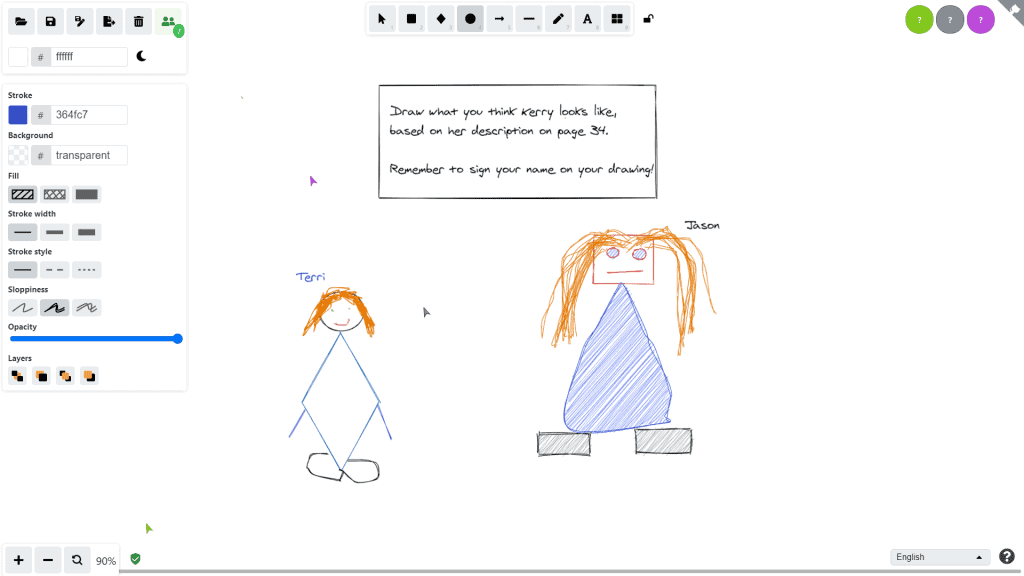
Strumento n. 2 – veyon
Molti insegnanti sono giustamente riluttanti a utilizzare il software di monitoraggio dello schermo nell'aula virtuale. Ma, Veyon offre molto di più.
Certo, Veyon ti consente di monitorare gli schermi e bloccare gli studenti fuori dalle sessioni, ma ti dà anche il potere di assumere il controllo degli schermi, il che significa che puoi aiuto con i fogli di lavoro e apportare correzioni.
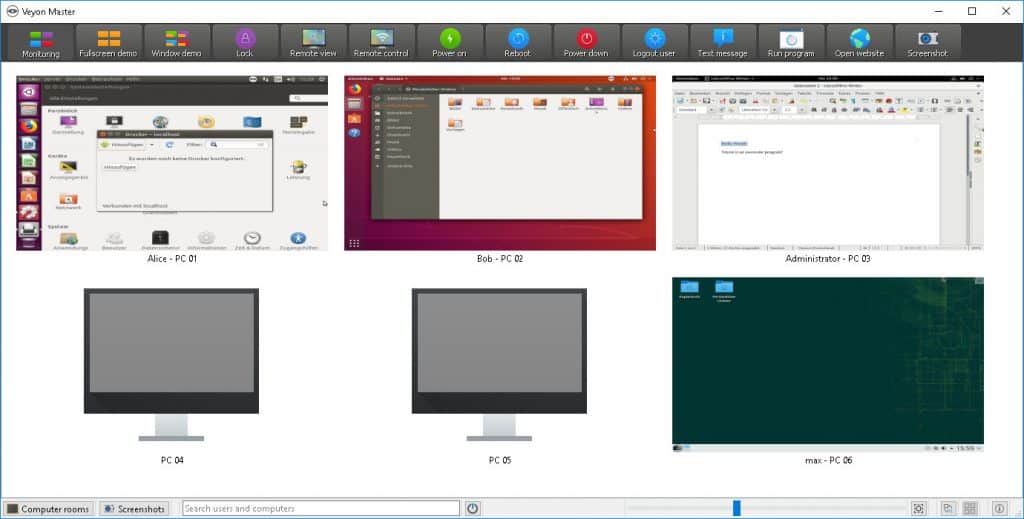
Strumento n. 3 – Flipgrid
Flipgrid si occupa di mantenere le cose sociale, in questi tempi lontani.
È uno strumento gratuito che ti consente di creare un argomento di discussione e condividerlo esclusivamente con i tuoi studenti. Quindi, incoraggia gli studenti a filmare una risposta video in cui possono parlare, eseguire or costruire qualcosa relativo al tuo argomento.
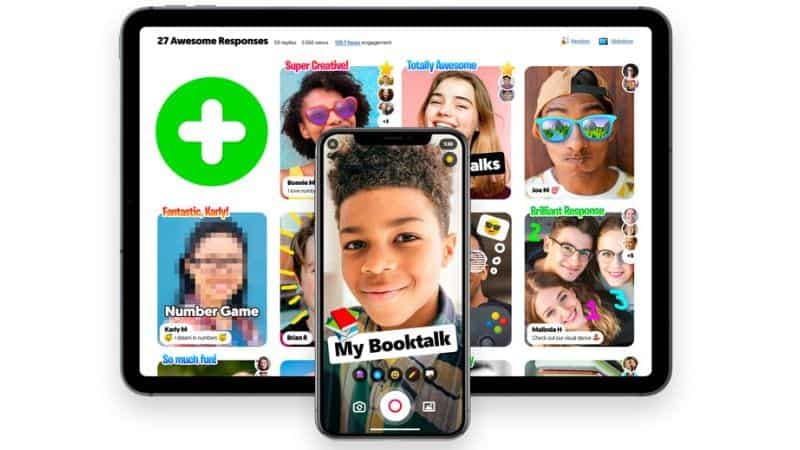
Strumento n. 4: Conosci il contenuto X
Se stai ancora utilizzando presentazioni unidirezionali di Google Slides o Powerpoint per le tue lezioni online, è il momento di iniziare interattivo.
AhaSlides è uno strumento gratuito che consente agli studenti di rispondere alle tue domande, votare nei tuoi sondaggi e svolgere i tuoi quiz e giochi in diretta dai loro telefoni. Tutto quello che devi fare è creare la presentazione, condividere il codice della stanza con i tuoi studenti e progredire insieme.
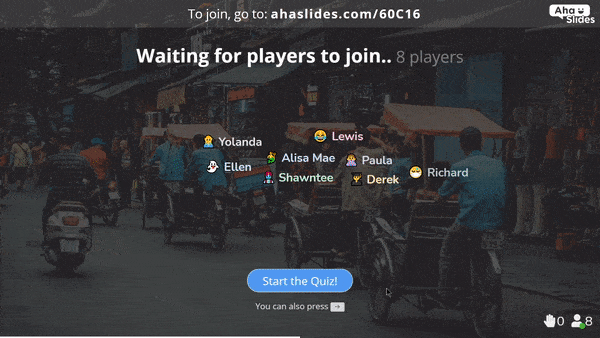
AhaSlides funziona anche per apprendimento asincrono. Puoi creare il tuo materiale, aggiungere sondaggi e domande, quindi lasciare che i tuoi studenti completino il corso nel momento più adatto a loro.
⭐ Vuoi provarlo? Iscriviti ad AhaSlides gratuitamente cliccando sul pulsante qui sotto!
Ci auguriamo che questo articolo sui pro e contro dell'e-learning vi abbia aiutato a chiarire alcuni dei vantaggi e degli svantaggi dell'apprendimento online. Ci auguriamo di avervi mostrato, in qualche modo, alcuni metodi che potete utilizzare per adattare la vostra didattica al mondo digitale. In bocca al lupo!
Più coinvolgimento con le tue riunioni
- La migliore ruota girevole AhaSlides
- Creatore di quiz online AI | Crea quiz in diretta | Il 2024 rivela
- AhaSlides Online Poll Maker ��� Best Survey Tool
- Generatore di squadre casuali | Rivelato il creatore di gruppi casuali del 2024



